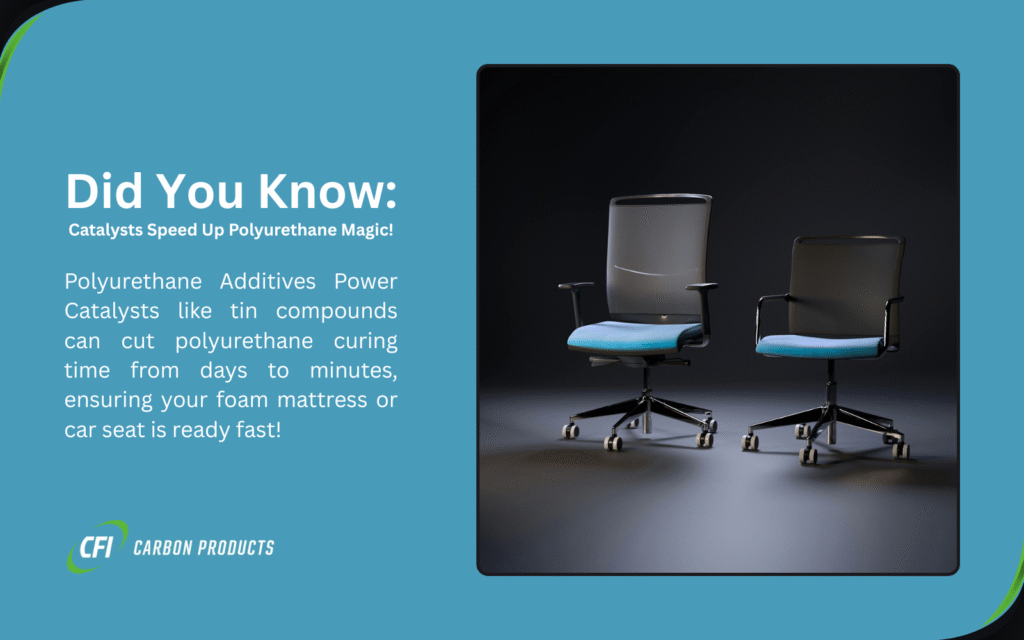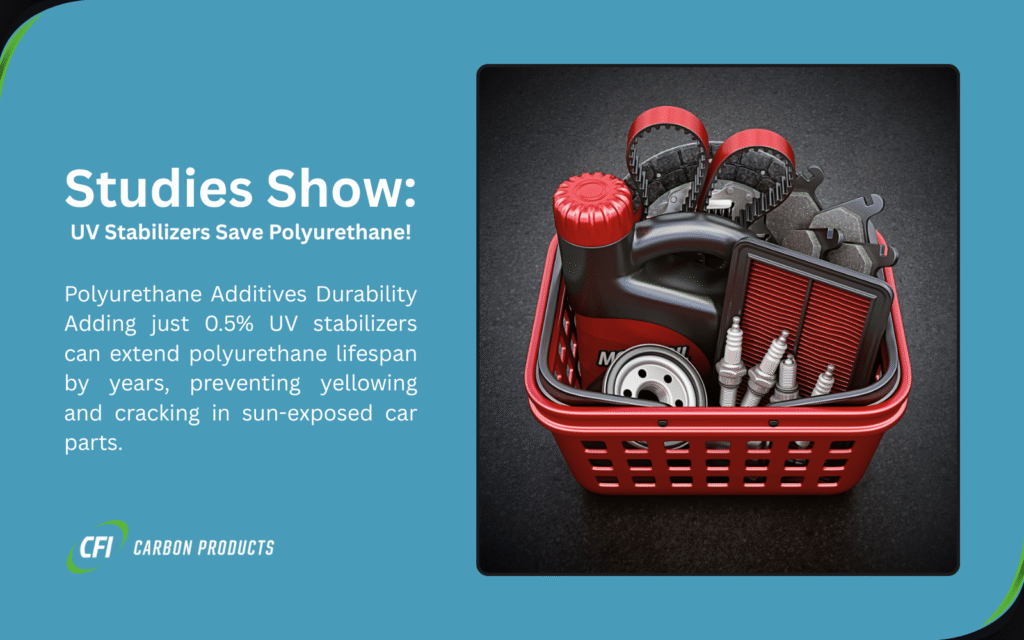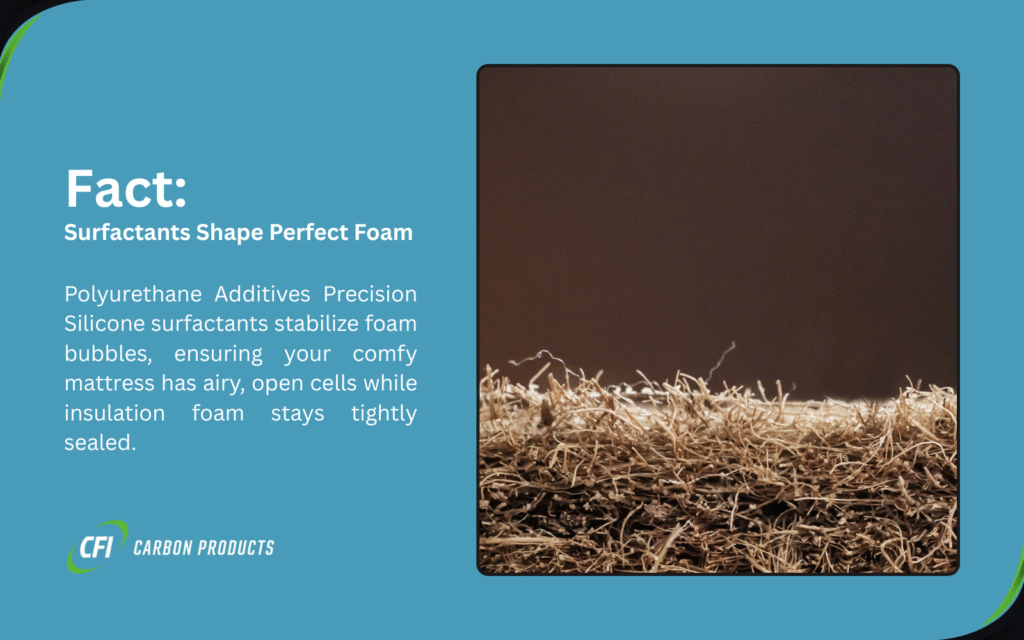Polyurethane additives are everywhere around us, but we rarely give them a second thought. I’ve been working with these materials for years, and I’m still amazed at how these specialized chemical compounds completely transform ordinary polyurethane into something extraordinary.
Honestly, without polyurethane additives, that cushy mattress you slept on last night would feel like a brick. Your car’s dashboard would crack after a year in the sun. That protective floor coating in your garage? It’d peel right up after one winter.
Throughout this article, I’m going to share what I’ve learned about polyurethane additives, both from textbooks and from getting my hands dirty in actual applications.
What Are Polyurethane Additives?
OK, so what exactly are polyurethane additives?
I once worked with a client who couldn’t figure out why their supposedly “premium” polyurethane flooring was yellowing after just six months. Turns out they were skimping on UV stabilizers—a crucial polyurethane additive for anything exposed to sunlight. Adding just 0.5% of the right stabilizer completely solved their problem! If you’re dealing with similar issues, you might want to check out some quality UV stabilizer additives.

It’s mind-blowing when you realize these additives might make up only 1-10% of the formula, but they’re doing like 90% of the heavy lifting when it comes to making the material actually usable. Polyurethane without proper additives is like a car without oil—technically it might run, but not for long and definitely not well.
Types of Polyurethane Additives
There are many types of plastic additives used in polyurethane formulations. Let’s explore the most important ones:
Catalysts
Let me tell you about catalysts. Probably the most critical polyurethane additives in the whole mix. Without them, you’d be waiting days for your polyurethane to cure instead of minutes or hours.
I learned this lesson the hard way during a home project when I tried mixing up some polyurethane without the proper catalyst. After 24 hours, it was still a sticky mess! Never made that mistake again.
These catalysts are conducting the entire chemical orchestra. Here’s what I mean:
- Tertiary amines (like triethylenediamine) push the blowing reaction forward, making your foam rise beautifully
- Tin catalysts (DBTDL is the go-to) drive the gelling reaction that creates the actual polymer network
- Some newer delayed-action catalysts are pretty clever—they stay dormant until hit with heat, letting you work with the mixture longer
I remember a technician friend who accidentally doubled the catalyst amount in an industrial formula. The polyurethane mixture basically exploded out of the mixing chamber—cured so fast they had to replace the entire processing line!
Surfactants
You know how oil and water don’t mix together? The same problem exists in polyurethane additives, especially for foams. That’s where surfactants come in.
One end of these molecules loves water, the other end hates it. This dual personality makes them perfect for stabilizing the bubbles in foam. Without good surfactants, your foam would collapse faster than a soufflé in an earthquake.
Silicone surfactants are the workhorses here. And the molecular structure matters tremendously. Longer chains for flexible foams, shorter for rigid ones.
Chain Extenders and Cross-linkers
Now let’s talk about chain extenders and cross-linkers. These might sound boring, but they’re actually where the magic happens in terms of how the final product feels and performs.
Think of chain extenders like the links in a chain—they connect segments of the polymer together in nice, orderly lines. Cross-linkers are more like creating a 3D spider web of connections throughout the material. Both drastically change how the polyurethane behaves.
The difference between using a diol (two functional groups) and a triol (three functional groups) is like the difference between building with Lincoln Logs versus creating a welded steel frame. Both can work, but they create fundamentally different structures.
Blowing Agents
The simplest blowing agent is actually just water. When water reacts with isocyanate, it creates carbon dioxide gas, instant bubbles.
These days, there’s been a huge shift away from the old CFC and HCFC blowing agents that were terrible for the ozone layer. The industry has moved toward hydrofluoroolefins (HFOs) and hydrocarbons, which are much more environmentally friendly.
Flame Retardants
Flame retardants are some of the most controversial polyurethane additives out there, but also potentially lifesaving. If you’ve ever seen how quickly untreated polyurethane foam can burn, you’d understand why these additives are non-negotiable for many applications.
There’s been a big push away from halogenated flame retardants (which work great but have environmental concerns) toward alternatives like:
- Phosphorus compounds that create a protective char layer
- Expandable graphite that swells up when heated
- Melamine derivatives that release nitrogen when burning
- Metal hydroxides that release water when heated
Getting the flame retardancy right without wrecking other properties is one of the toughest balancing acts in formulating polyurethane additives.
Antioxidants and UV Stabilizers
Nothing lasts forever, but with the right polymer additives, materials can last a whole lot longer. Without stabilizers, many polyurethanes would degrade within months or even weeks.
UV light is particularly brutal on polyurethanes. Many untreated polyurethane car parts turn yellow and brittle after just one summer. The right UV stabilizers can keep the same parts looking new for years.
Most people don’t realize that oxygen is actually slowly destroying most polymers around us. It’s a constant chemical attack that antioxidants help fend off. They work sort of like dietary antioxidants—sacrificing themselves to neutralize the free radicals before they can damage the polymer chains.
Colorants and Pigments
Color might seem like just an aesthetic concern, but when it comes to polyurethane additives, it gets surprisingly technical. The wrong pigment can destabilize your entire formula.
What’s fascinating is how different applications need totally different approaches:
- For automotive interiors, you need incredible color consistency—the dashboard can’t look different from the door panels.
- For industrial flooring, UV stability over decades is crucial. For novelty items, bright, eye-catching colors might be the priority.

Fillers
Sometimes I think fillers are the most underappreciated polyurethane additives. People assume they’re just cheap extenders to reduce cost, but good fillers are engineering materials in their own right.
Take calcium carbonate. Add the right grade and amount to a polyurethane elastomer, and you can improve compression strength by 30% while cutting material costs.
I’ve seen some really creative uses of fillers:
- Glass microspheres to create buoyant marine foams
- Carbon black that turns insulating foam into static-dissipative material
- Barium sulfate that makes polyurethane visible on X-rays for medical applications
- Aluminum trihydrate that improves both flame retardancy and abrasion resistance
How Different Industries Use Polyurethane Additives
Different industries use these additives in different ways.
Foam Makers and Their Additive Tricks
I’ve spent countless hours in foam plants, and I’m still amazed at how polyurethane additives completely transform the process and product. The difference between flexible and rigid foam it’s all about the additives.
Here’s a real-world comparison I’ve observed:
| What They’re Adding | Comfy Mattress Foam | Insulation Board Foam |
| Catalyst Packages | Gentler, carefully balanced systems that give time for proper rise before gelling | Aggressive catalysts that promote trimerization—those foam boards need to be rock-solid |
| Surfactant Power | Lower potency—they want those cells to pop open for air flow | High-power surfactants that keep every cell sealed tight for better insulation |
| Blowing Agent Choices | Mostly just water for flexible foam | Complex blends of water plus physical blowing agents like pentane |
| Cell Openers | Absolutely necessary—otherwise you’d sink into your mattress and never come back up! | Actually harmful—would ruin insulation value |
Coating Folks and Their Surface Obsessions
When it comes to polyurethane coatings, it’s all about the surface. One tiny crater in a glossy floor coating, and customers are on the phone complaining.
What makes coatings such a challenge is that polyurethane additives need to:
- Help the coating flow beautifully during application
- Prevent defects like fish eyes and orange peel
- Aid in adhesion to difficult substrates
- Control how light reflects off the surface (gloss level)
- Then disappear from the equation, never causing haziness or separation
Elastomer Engineers and Their Durability Demands
Polyurethane elastomers (the rubber-like polyurethanes) have to withstand incredible abuse—think skateboard wheels, industrial rollers, and mining equipment parts. The polyurethane additives make all the difference between a part that fails in weeks versus one that lasts for years.
The polyurethane additives these applications need include:
- Internal mold release agents so parts don’t stick in complex molds
- Anti-hydrolysis agents to prevent water degradation
- Processing aids that help the liquid material flow into intricate mold details
- Antioxidants specifically designed for high-temperature service
What’s New in Polyurethane Additives Industry
There are many new things that are happening in this industry.
Going Green Without Performance Trade-offs
The sustainable polyurethane additives trend is finally getting real momentum. I’m particularly excited about:
- Catalysts designed specifically for CO2-based polyols, which actually use captured carbon dioxide in the polymer
- Bio-based flame retardants derived from plant sources that perform surprisingly well
- Natural oil-based surfactants that create more consistent cell structures
- Renewable plasticizers that maintain flexibility better than phthalates ever did
And honestly, a lot of this innovation is being driven by regulations—whether it’s VOC limits, REACH restrictions, or customer sustainability demands. But the results are impressive regardless of what’s driving it.
Do-It-All Additives
One thing I’m seeing more and more is manufacturers wanting to simplify their polyurethane additives packages. Nobody wants to juggle 12 different additives if they can get the same effect with 4 or 5.
This has led to some clever multifunctional additives hitting the market. I think this trend is just getting started. The additive companies with the best chemists are combining functions in ways we wouldn’t have thought possible ten years ago.
Regulatory Headaches and Adaptation
The changing regulatory landscape for polyurethane additives has been a massive headache for many manufacturers. But it’s also driving innovation.
Right now, I’m seeing huge efforts around:
- Low-VOC additives that don’t compromise performance
- Food-contact compliant formulations with improved migration resistance
- Flame retardants that meet increasingly strict fire codes without using halogenated compounds
What’s most interesting is how regional regulations are creating different polyurethane markets. A formula that’s perfectly legal in one country might be completely unusable in another due to differing restrictions on polyurethane additives.
Choosing the Right Polyurethane Additives
After years of formulating, I’ve developed something of a methodology for selecting polyurethane additives.
First, I always start with the end-use requirements. What environment will this be used in? What temperatures? Any chemical exposure? Will appearance matter? How long does it need to last? The answers immediately narrow down your options.
Here’s what I’ve learned to consider:
- Manufacturing process constraints are often the most limiting factor. A formula that works perfectly in the lab might be impossible to process in high-volume production.
- Regulatory requirements can eliminate otherwise perfect technical solutions. Always check these early!
- Cost is always a factor, but I’ve learned to look at system cost, not just raw material cost. Sometimes more expensive polyurethane additives actually reduce total cost by improving yields or reducing scrap rates.
- Supplier expertise matters enormously. The best additive suppliers don’t just sell chemicals—they provide formulation expertise that can save months of development time.
- Testing, testing, and more testing. Polyurethane additives can have surprising interactions that only show up under specific conditions or after aging.
One hard lesson I’ve learned: never make assumptions about compatibility. Choosing appropriate polyurethane additives requires consideration of several factors:
- Application requirements: What properties are most critical for the end use?
- Processing method: Different manufacturing techniques require different additive profiles
- Compatibility: Will the additives work well together and with the base polyurethane system?
- Regulatory compliance: What restrictions apply to the intended market?
- Cost considerations: What is the acceptable price point for the application?
Formulation development typically involves multiple iterations, starting with small-scale laboratory tests and progressing to production trials.

Common Challenges with Polyurethane Additives
Even experienced formulators encounter challenges with polyurethane additives:
Balancing Competing Properties
Improvements in one property often come at the expense of others. For example:
- Increasing flame retardancy may reduce mechanical properties
- Enhancing hardness often reduces flexibility
- Lower density typically means lower strength
Finding the right balance requires understanding which properties are non-negotiable for the application.
Additive Interactions
Polyurethane additives may interact in unexpected ways:
- Certain flame retardants can deactivate catalysts
- Some fillers can adsorb surfactants, reducing their effectiveness
- UV stabilizers might affect color stability
Thorough testing is essential to identify potential incompatibilities.
Processing Window Challenges
Additives can narrow the processing window:
- Accelerated reactions may reduce working time
- Some additives increase viscosity, making processing more difficult
- Temperature sensitivity may be increased
Adjustments to processing parameters are often necessary when modifying additive packages.
Summary
Polyurethane additives transform basic polyurethane chemistry into the versatile, high-performance materials we rely on daily.
These specialized ingredients control reaction rates, physical properties, durability, appearance, and processing characteristics. From the flexible foam in your car seats to the rigid insulation in your home and the durable coatings protecting various surfaces, polyurethane additives make modern applications possible.
As the industry continues to innovate, we’re seeing exciting developments in sustainable additives, multifunctional performance, and compliance with evolving regulations. Understanding the complex interplay between different polyurethane additives is key to successful formulation development.

